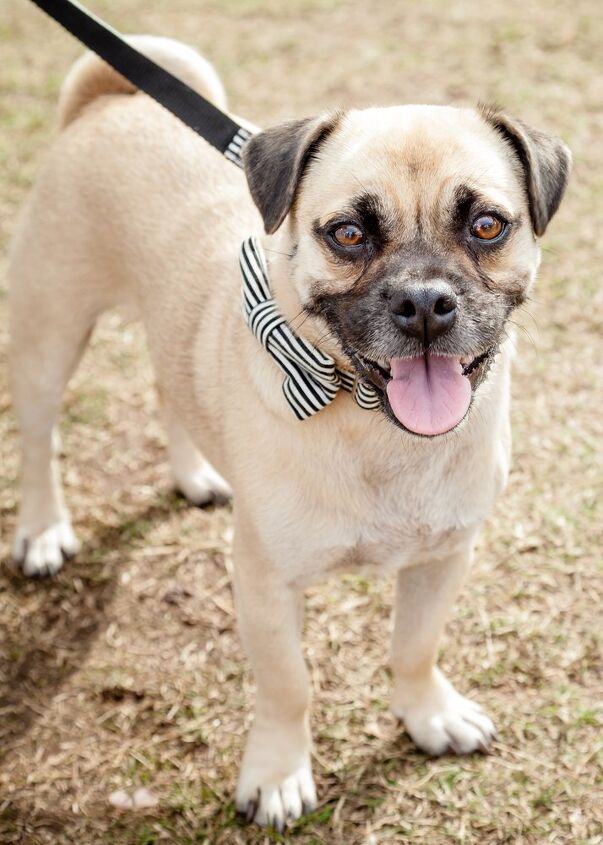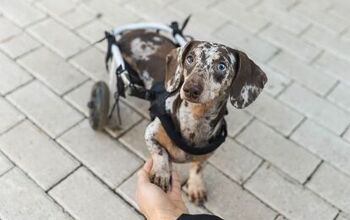Pug-A-Mo


About Pug-A-Mo
The inquisitive little Pug-A-Mo is a great family dog that is highly active, playful and loves to hang out with his human pack. This perky little dog brings together the affectionate nature of the Pug and the keen-to-please personality of the American Eskimo Dog for a busy little companion dog that loves to play and is highly curious about anything and everything – so always entertaining. He is known to be highly protective of his family, will be quick to bark as often as he deems necessary and can be territorial about his food and toys – so this little guy will need some early socialization to teach him how to play nice.
The curious Pug-A-Mo brings together the affectionate Pug and the keen-to-please American Eskimo Dog.
The Pug-A-Mo is a Designer Dog and as such, likely dates back to the 1980’s or 1990’s when breeders first began crossing two or more pure-breds dogs with the goal of producing a pet that would be typically healthier, sometimes non-shedding, often smaller and even gentler than many of the more popular breeds. With the Pug-A-Mo, his pure-bred parents include the Pug and the American Eskimo Dog and although he himself dates back just a quarter-century, he has some pretty serious lineage. The American Eskimo Dog was originally named the German Spitz and in the early 20th century this animated little dog performed at travelling circuses throughout Germany. After arriving in North America, he was renamed the American Eskimo Dog due to the anti-German sentiment that followed World War I. The Pug dates back to ancient China where he was bred as a valued pet of the Chinese emperors. He later became a favorite of the Buddhist monks where he became the resident dog in Tibetan monasteries. Around the 16th century he began to appear in European Courts where yet again, he was the favored pet of royalty and ultimately immortalized in paintings by artists such as Goya. This animated little pooch arrived to North America in the 19th century.
With the American Kennel Club (AKC) focused on advocating for pure-bred dogs the cross-bred Pug-A-Mo doesn’t qualify to become a member of the famed club however both of his parent breeds are members in good-standing. The American Eskimo Dog was named to the “non-sporting” group in 1994 and is considered to be playful, perky and smart while the full-of-personality Pug joined the “toy” group back in 1885 and is described as being charming, mischievous and loving.
While the Pug-A-Mo is a busy, energetic dog his exercise needs to be taken in moderation because of potential respiratory issues. This impacts his diet because this dog has a propensity to become obese and with joint issues a potential problem later in life, you need to establish an ideal weight and design his diet around it. Choose a nutrient-rich variety of top quality kibble that is higher in protein versus the carbohydrates that will ultimately cause him to want to over-eat to feel full. Plan to feed him two to three smaller meals throughout the day rather than allowing him to free-feed and be sure to offer up treats only as earned. Because your Pug-A-Mo will likely inherit the flatter, brachycephalic facial structure of the Pug, eating can be a challenge and cause him to gulp air and become excessively flatulent – so check out some of the food and water dishes that have a slight ergonomic tilt for easier access and a cleaner dining experience for this type of dog.
The Pug-A-Mo is a smart, curious dog who will love to learn new skills and accept the resultant rewards for a job well done. With house-breaking often a challenge with small dogs, consider crate training with scheduled “potty breaks” throughout the day to help get him into a routine that works for both of you. Because the American Eskimo Dog is known to be a barker, obedience training that will help curb this behavior is important and should begin at a very young age while he is more likely to listen and obey commands. Similarly, socialization will help with his territorial nature and encourage him to play nice with others. Exposure to new faces, animals, smells, sights and sounds in a positive, controlled manner will help in this regard. As with any dog, a firm consistent approach that reinforces the rules and establishes your expectations with rewards of treats and verbal praise, will go a long way in netting the results you’re seeking.
Your Pug-A-Mo comes from two solid, but smaller dog breeds and when fully grown you can expect him to weigh somewhere between 15 and 25 pounds with the heavier weight being influenced by gender.
The Pug-A-Mo is a curious little dog who loves to explore and will be the first to check out a strange noise – and then bark (and bark, and bark…) to let his family know of his discovery. While he’s loving, playful, entertaining and great with other animals, that protective instinct causes him to be somewhat territorial and downright aggressive if he feels his food or toys are in danger of being taken. So early socialization will be necessary to ensure he doesn’t become snappish around young children or family pets. Likewise, around strangers where he will vocalize his caution and concern before warming up to them. Both the Pug and American Eskimo Dog are known to suffer from separation anxiety and with the latter, this can result in incessant, high-pitched barking – a trait that is likely to be passed along to the Pug-A-Mo and means he is best suited for a house versus apartment and ideally where a family member is at home. This little dog is also prone to suffer from separation anxiety which can again, result in barking as well as other destructive behaviors. For those times where he does have to be left alone, puzzle games with hidden treats that he has to work for, are a great way to occupy this intelligent pooch during those first 10-15 minutes after your departure – which is often the most stressful time for a dog.
While Designer Dogs are typically bred to be healthier than either of their pure-bred parents it’s important to do a little research to better understand what your new family member may inherit later in life. With the Pug-A-Mo this can include respiratory issues due to his brachycephalic facial structure, cataracts, dry eye and from the American Eskimo Dog side, progressive retinal atrophy (PRA). With both breeds, joint issues such as patella luxation and hip dysplasia may become a concern and if your pooch inherits the heavier facial folds of the Pug, skin infections can be a smelly problem. With the latter, simple preventive measures such as daily cleaning is an easy fix. Additionally, the Pug side of this little guy is renowned for his flatulence due to gulping air as he eats and this too, can be easily resolved through his diet and feeding method. While this may seem like a daunting list of potential issues, don’t be put off. Your little Pug-A-Mo may never experience a sick day in his life.
The Pug-A-Mo is a small- to medium-sized dog that is somewhat active and with regular exercise, a diet designed for his age, size and energy level as well as annual check-ups with your vet to monitor his health, you can expect he will live a happy, healthy life of between 12 and 15 years.
The Pug-A-Mo’s highly active American Eskimo Dog background will almost certainly produce a dog that has a curious nature and loves inter-active playtime and exploring. For this dog, add in a couple of short, daily walks and this should be sufficient to keep him mentally stimulated and physically fit. With the brachycephalic nature of the Pug meaning he will likely have the flatter face, activity should be moderated during hot weather when respiratory issues can become a problem. Short walks and playtime that is scheduled for early morning or late evening is ideal in warmer weather, with his pet parent always watching for clues that he needs a rest and time to cool down – keep water handy and be prepared to take breaks as needed. Dog parks are also a great way to squeeze in activity and give him the opportunity to interact with other dogs. Socialization is particularly important as a thrown ball grabbed by another pooch may result in a stand-off. Because this is an intelligent little dog, he needs the stimulation and physical outlet that comes from exercise in order to prevent destructive behaviors, so never skip this step.
The curious Pug-A-Mo is both playful and protective making him somewhat territorial.
While the little Pug-A-Mo’s cross-breed status means he will never qualify to join the American Kennel Club’s roster of purebred dogs, he is recognized by the Dog Registry of America, Inc. (DRA).
The Pug-A-Mo will typically have the colors of the Pug with a white or cream body and dark markings around his face, His coat will be silky and longer than that of the Pug, but no where near as full as that of the American Eskimo Dog. Because both parent breeds shed heavily, expect to brush your pooch 3 to 4 times a week to help prevent tangles and matting. During shedding seasons, brushing will be needed daily to keep loose hair from taking over your home and vehicle. As your new pup is likely to inherit some of the facial folds common with the Pug, you will need to clean creases daily to prevent smelly yeast infections – which is a known problem with heavily wrinkled dogs. And with floppy eared dogs prone to the same type of yeast infections, a weekly inspection and cleaning with a damp cotton ball should become an important part of his grooming.
Your new Pug-A-Mo puppy will almost certainly inherit both the loving personality of the Pug and the inquisitive, territorial nature of the American Eskimo Dog and this means that early socialization will be needed to prevent food guarding and potentially aggressive behaviors. This can be as simple as exposing him to new people, smells, sights and animals while he is young and always in a positive, controlled setting. Building his confidence will help curb the cautious, protective side of this dog that can be overly-reactive and yappy when in unfamiliar settings. This pup can experience joint issues later in life and together with a propensity for becoming obese, it’s important to ensure meals are structured from an early age and that exercise / playtime doesn’t over-exert his tiny limbs.
Photo credit: SJ Allen/Shutterstock; John Kropewnicki/Shutterstock; Steve Shoup/Shutterstock

Sharing space with three seriously judgy Schnoodles and a feline who prefers to be left alone. #LivingMyBestLife
More by Mary Simpson

























